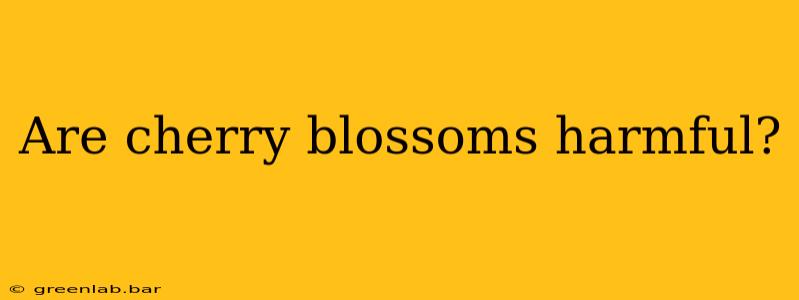Cherry blossoms, those delicate pink and white blooms that signal the arrival of spring, hold a special place in many cultures. Their breathtaking beauty inspires poetry, art, and festivals worldwide. But beyond their aesthetic appeal, a question arises: are cherry blossoms harmful? The answer, like the blossoms themselves, is nuanced.
The Allure of Cherry Blossoms: More Than Just Pretty Flowers
The captivating allure of cherry blossoms stems from their ephemeral nature. Their fleeting beauty, lasting only a few weeks, adds to their mystique and cultural significance. They represent renewal, hope, and the transient nature of life. However, this beauty doesn't negate the need to understand their potential impact on our environment and health.
Potential Allergic Reactions: A Springtime Concern
For some, the beauty of cherry blossoms comes with an unwelcome side effect: allergies. Cherry blossoms, like many flowering plants, release pollen into the air. This pollen is a common allergen, causing symptoms such as:
- Runny nose: A constant drip can be disruptive and uncomfortable.
- Sneezing: Frequent sneezing fits can be both irritating and socially awkward.
- Itchy, watery eyes: This can lead to discomfort and impaired vision.
- Coughing: Pollen can irritate the airways, leading to a persistent cough.
The severity of allergic reactions varies greatly depending on individual sensitivity and pollen concentration. People with existing allergies, particularly to other plants in the Rosaceae family (like apples and pears), are more susceptible. If you experience severe allergic symptoms, consult a doctor or allergist.
Minimizing Allergic Reactions: Practical Tips
While you can't entirely eliminate pollen exposure, you can take steps to mitigate its effects:
- Check pollen counts: Many weather forecasts provide daily pollen counts, allowing you to plan outdoor activities accordingly.
- Stay indoors during peak pollen hours: Pollen counts are generally highest in the late morning and early afternoon.
- Close windows and use air conditioning: This helps prevent pollen from entering your home.
- Shower and change clothes after being outdoors: This removes pollen from your hair and clothing.
- Consider medication: Over-the-counter antihistamines can provide relief from allergy symptoms.
Beyond Allergies: Other Potential Issues
While allergic reactions are the most common concern, other potential issues related to cherry blossoms exist, although they are less prevalent:
- Messy cleanup: Fallen cherry blossoms can create a considerable mess, requiring cleanup.
- Potential for fungal growth: In humid conditions, fallen blossoms can encourage fungal growth.
These issues are largely manageable through regular cleanup and maintenance.
Conclusion: Appreciating the Beauty While Mitigating Risks
Cherry blossoms are undeniably beautiful, but understanding their potential to cause allergic reactions and other minor inconveniences is crucial for safe enjoyment. By being aware of these potential issues and taking preventative measures, you can fully appreciate the enchanting beauty of these springtime blooms without compromising your health or comfort. Remember, if you experience severe allergic symptoms, seeking medical advice is essential.

